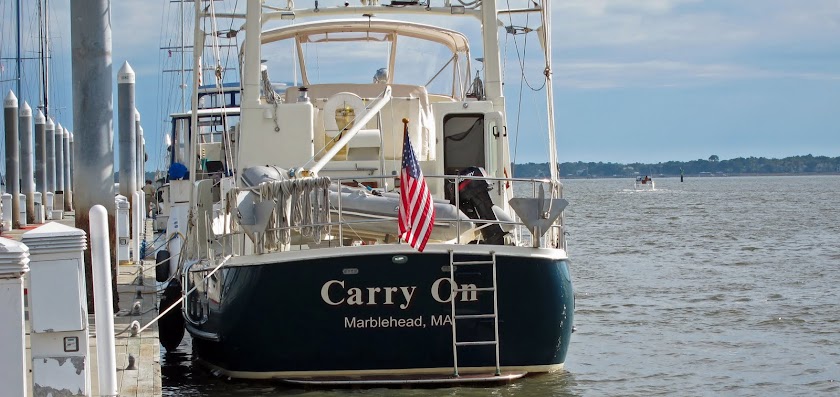 |
| Miami Sunset |
Phew-- it’s been a long time and it seems like we’ve been a lot of places or done a lot of things, or time is just flying as usual. If you’ve looked for us in the last couple of weeks, we’ve been a bit forgetful about putting the “SPOT” out where it can do its thing, so I’ll try to catch you up on the where and what we’ve been up to.
 |
| Cape Florida Light, Key Biscayne |
Before we left our Miami marina home on March 10, we managed to get in all our last errands and do some more sightseeing before turning in our car. We visited Vizcaya, the mansion and grounds of James Deering (International Harvester) and found it a great example of incredible excess, which of course makes for an interesting visit and a great audio tour! Built during WWI, at one time it employed 10% of the population of Miami. Whole rooms and crumbling ceilings were imported intact (or reconstructed crumbles) from sites in Italy and France, along with virtually all other furnishings which were chosen personally by Deering and his mentor/ architect on long trips abroad. Some difficulties apparently occurred with the shipping of his purchases due to the war in Europe. Our visit was enhanced by young women posing in elaborate costumes and gowns for their Quinceanera photos, very much a part of the everyday happenings at Vizcaya in the 21st century!
We spent a morning exploring Fairchild Botanical Gardens, the only subtropical plant collection in North America-- the themed gardens were all quite spectacular, particularly the orchids growing in the rain forest. Another morning we visited the Florida History Museum, one of the few things we did in downtown Miami. We had planned a quick hour to visit, but after a couple of hours had to give up finishing because of general overload, not to mention growling tummies. So--- enough on the sightseeing.
 |
| Stiltsvville, Biscayne Bay |
We spent a weekend on the hook at one of my favorite anchorages, in Miami Beach, below the Venetian Causeway. We were there last year and it was one of the reasons we become enthralled with the Miami area. As the sun goes down, lights begin to twinkle in 360 degrees from the skylines of Miami and South Beach. Combine that with the cruise ship traffic late in the afternoon and I always found myself looking forward to the end of the day. But then, another highlight is the dinghy trip from the boat through the Collins Canal over to South Beach-- what a kick going under the low bridges, the overhanging trees and tying up midway to make a quick trip to the grocery store across the street!
 |
| Dingy Route to South Beach |
This year we timed our arrival at Cape Florida State Park/ Bill Baggs Recreation Area so that we were able to find a lovely spot with ample swinging room to drop our anchor in tiny No Name Harbor. After lunch I took the mile or so walk to the Cape Florida lighthouse at the lower tip of Key Biscayne, looking at the fisherman gathered at the small piers along the outer path and marveling once again at Stiltsville. The houses there, built in the 1930’s on a sandbar, have a colorful past. Barely surviving Hurricane Betsy in 1965, they were further devastated by Hurricane Andrew in 1992. They now lie legally protected from the wrecking ball, within the Biscayne Bay National Park area, but the seven structures remaining are now barely more than campsites.
We’ve had so little company on board this winter, so were delighted when our niece and her husband, along with our great-nephew, joined us for the short trip up from Miami to West Palm Beach. We had a great time, but it was a short visit, and we left them in West Palm Beach Friday evening to fly home again.
 |
| Skipper Resting, Collins Canal, Miami Beach |
We’re now in Ft Pierce, having arrived Saturday from Palm Beach, traveling outside, along the coast to miss the three challenging and grumpy Jupiter bridge tenders. It’s been a long time since we’ve been underway any distance, and an even longer time out of the protected waters of the ICW. Bubba and I had our sea legs challenged-- I was fine by early afternoon after crackers and my seasick bands, but poor Bubba spent the day under the bedspread feeling miserable.
All in all, we are feeling that we are in very good shape boatwise, with a little help
from Scotty and a very flexible (physically, literally!) mechanic who was able to twist himself over, down and around to replace a part in the 12KW generator. And I’m happy to report to anyone who cares that our Florida registration numbers are now painted on our inflatable-- yes! I can finally cross that one off.
We’re all happy campers and it’s getting warm down here. We’ve loved our winter in Florida, but it’s time to head north and we’re looking forward to seeing friends and family in the Boston area.
I think I’ve rambled on enough for one sitting-- the next entry will be shorter, I promise!





